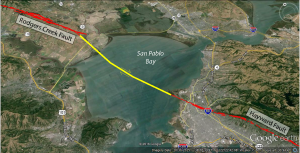Janet Watt, USGS
Moss Landing Marine Labs Seminar Series - April 26th, 2018
Hosted by the Geological Oceanography Lab
MLML Seminar Room, 4pm
Open to the public
Janet Watt received her M.S. in Marine Science (Geological Oceanography) from Moss Landing Marine Laboratories in 2004 while working at the U.S. Geological Survey in Menlo Park, CA. As part of the Geophysical Unit of Menlo Park (GUMP), She used potential-field methods (gravity and magnetics) and 3D geologic mapping to understand earthquake and volcano hazards, and mineral and water resources in the western U.S. In 2010, She returned to her marine geology roots and joined the Pacific Coastal and Marine Science Center in Santa Cruz, CA where she currently works as a Research Geophysicist.
Her research focuses on characterizing onshore/offshore geologic structure, deformation, and active tectonics to address problems focused on geologic hazards and framework geologic processes. Her recent work involves the development and application of integrative geophysical approaches to 3D characterization of faults and fault interactions.
Underwater secrets of the Hayward fault zone: integrated 3D imaging to understand earthquake hazards
The next major earthquake to strike the ~7 million residents of the San Francisco Bay Area will most likely result from rupture of the Hayward or Rodgers Creek faults. Until now, the relationship between these two faults beneath San Pablo Bay has been a mystery. Detailed subsurface imaging provides definitive evidence of active faulting along the Hayward fault as it traverses San Pablo Bay and bends ~10° to the right toward the Rodgers Creek fault. Integrated geophysical interpretation and kinematic modeling show that the Hayward and Rodgers Creek faults are directly connected at the surface—a geometric relationship that has significant implications for earthquake dynamics and seismic hazard. A direct link enables simultaneous rupture of the Hayward and Rodgers Creek faults, a scenario that could result in a major earthquake (M = 7.4) that would cause extensive damage and loss of life with global economic impact.


